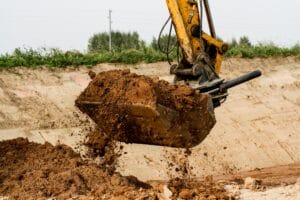A wetland is an area of land that exemplifies wetland soils, vegetation, and wetland hydrology. Wetlands contain water-loving animals and plants known as hydrophytes. These ecosystems also have low aerobic levels or low oxygen levels.
According to the Natural Academy of Sciences, an area’s soil must be saturated with water for more than two weeks and at a depth greater than one foot to be considered a wetland. Saturation must occur during the growing season and for most of the year.
The Importance of Wetlands
The benefits of wetlands cannot be overstated. Wetlands act as natural sponges that trap naturally-occurring water in the form of rain, snow melt, floods, and groundwater.
Additionally, they act as habitats for thousands (if not millions) of aquatic and terrestrial animals. Wetlands are valuable for flood control, aesthetics, recreation, and shoreline erosion control.
Identifying and delineating wetlands becomes critical when laying down construction and rehabilitation plans. Land evaluators and contractors must follow delineation guidelines in constructing private and commercial properties. Identifying wetland boundaries lays a foundation for sustainable construction and sustainable development.
Importance of Wetlands Identification and Delineation
So, what’s the importance of doing wetlands identification and delineation?
1. Clean Water
Conducting wetland delineation provides clean drinking water to communities and societies. Wetland identification protects boundaries from possible sources of on-point and off-point pollution, including direct and indirect pollution.
The emergence of wetland identification and delineation efforts began with the Clean Water Act. The Clean Water Act called for the protection of all-natural water bodies in the United States.
The United States adopted the Clean Water Act following rising concerns about water pollution emanating from industrial run-offs, boat activities, and agricultural run-offs.
The US Marine Corps of Engineers has been tasked nationally with restoring degraded ecosystems and has developed a detailed technical guideline for determining and delineating wetland areas.
2. Project Initiation
Wetland identification and delineation is a critical step for engineers and land developers. It’s a first step in eliminating any potential roadblocks that may exist toward developing land for a specific use.
Pinpointing a wetland boundary within a plot of land may eliminate the possible destruction of wetland ecosystems. In the United States, the Department of Environmental Protection DEP regulates wetlands, and violations of existing regulations may attract steep penalties, including delayed projects.
3. Risk Elimination
Identifying wetland boundaries helps to identify and eliminate potential and inherent project risks. For instance, a project may be proposed in a space inhabited by an endangered species, a stream of water, a unique soil component, or a mineral.
In this case, the law requires that the project be modified to minimize its impact on the protected ecosystem. In this case, the project financiers or owners may decide to construct another man-made wetland to continue with the project. So, wetland identification is a critical first step in ensuring that projects do not inhibit or impede naturally existing ecosystems – including wetlands.
4. Project Sustainability
Sustainable projects protect endangered species and ecosystems. For instance, road construction that fails to include sustainability to project lifecycles is likely to lead to short-term monetary benefits over long-term gains.
Therefore, wetland identification and delineation allow engineers, architects, and building professionals to participate in the sustainability effort. By identifying wetland boundaries and what exactly constitutes wetlands, contractors and land developers can effectively protect these endangered ecosystems.
The Clean Water Act provides legal guidelines that enable contractors and commercial developers to be a part of the sustainability dream. Through carefully-documented guidelines, policies, and laws, contractors can use the Clean Water Act to steer sustainability in their day-to-day projects through programs like wetland identification and delineation.
5. Flood Protection
Wetlands act as operatives that trap naturally occurring water and slowly release this water in the form of snowmelt, rain, surface water, and groundwater. Root mats, trees, and wetland vegetation slow the movement of flood water, redirecting this water to the flood plains. The combined water storage reduces soil erosion and naturally lowers flood heights.
Implementation of Wetland Identification – Maryland, Virginia, and D.C.
The Marine Corps of Engineers must collaborate with the Department of Environmental Protection to protect wetland ecosystems through documented guidelines. In Maryland, the Department of Environment is responsible for the clean water act implementation.
In Virginia, the Department of Environmental Quality is responsible for water quality. And in the District of Columbia, the Department of Energy and Environment DOEE is responsible for this act. So, the implementation of wetland identification and delineation handles various inter-state jurisdictions that differ from state to state.
DFM Development Services – Experts in Wetlands Identification and Delineation
DFM Development Services is a team of environmental professionals that provides a wide range of environmental services, including environmental site assessments, environmental impact assessments, and wetland identification and delineation services – among many others.
Our experts understand the importance of wetlands identification and delineation. We have the knowledge to determine whether your property (commercial or public alike) touches on wetland boundaries.
We can identify a wetland from an upland location by looking at the soil type, vegetation type, hydrology, and plant life. If you’re looking for experts or certified environmental professionals to assess your property for wetland identification and delineation, don’t hesitate to contact us.




